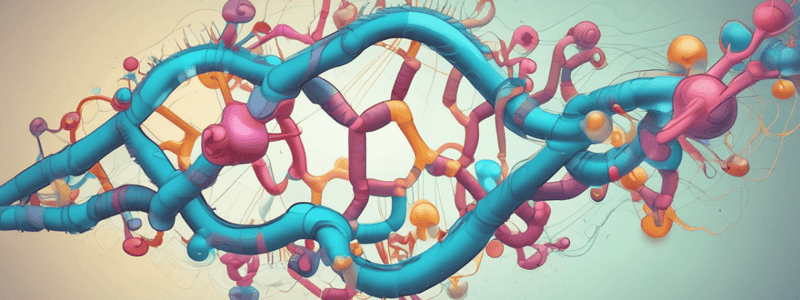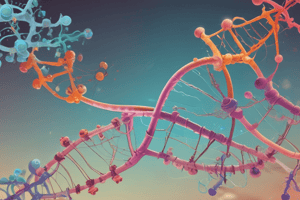Podcast
Questions and Answers
What is the function of the 18S/16S rRNA component in the ribosome?
What is the function of the 18S/16S rRNA component in the ribosome?
- Recognizes and binds to tRNA during translation
- Forms the small subunit of the ribosome (correct)
- Forms the large subunit of the ribosome
- Catalyzes peptide bond formation during translation
What is the primary location where rRNA processing occurs?
What is the primary location where rRNA processing occurs?
- Nucleolus (correct)
- Cytoplasm
- Nucleus
- Golgi apparatus
What is one mechanism by which rRNA synthesis is regulated?
What is one mechanism by which rRNA synthesis is regulated?
- Protein degradation
- Transcriptional regulation (correct)
- RNA interference
- Post-translational modification
What is the role of rRNA in protein synthesis?
What is the role of rRNA in protein synthesis?
What is the name of the RNA polymerase responsible for transcribing rRNA genes?
What is the name of the RNA polymerase responsible for transcribing rRNA genes?
What is the result of improper regulation of rRNA synthesis?
What is the result of improper regulation of rRNA synthesis?
Flashcards are hidden until you start studying
Study Notes
Structure
- rRNA (ribosomal RNA) is a type of non-coding RNA that makes up a large part of the ribosome
- Composed of two main components: 18S and 28S rRNA in eukaryotes, and 16S and 23S rRNA in prokaryotes
- 18S/16S rRNA forms the small subunit of the ribosome, while 28S/23S rRNA forms the large subunit
- rRNA is highly structured, with many stem-loop and pseudoknot structures
Processing
- rRNA is synthesized as a precursor molecule, which is then processed to form the mature rRNA
- Processing involves:
- Cleavage of the precursor molecule to form the individual rRNA components
- Modification of the rRNA, such as methylation and pseudouridylation
- Assembly of the rRNA into the ribosome
- Processing occurs in the nucleolus, a region within the nucleus
Regulation
- rRNA synthesis is regulated by a variety of mechanisms, including:
- Transcriptional regulation: controlling the rate of rRNA synthesis
- Post-transcriptional regulation: controlling the processing and stability of rRNA
- Epigenetic regulation: controlling the accessibility of rRNA genes to transcription factors
- Regulation is important for maintaining cellular homeostasis and responding to changes in the environment
Function
- rRNA plays a central role in protein synthesis, providing the platform for mRNA translation
- rRNA recognizes and binds to mRNA, positioning it for translation
- rRNA also catalyzes peptide bond formation during translation
- rRNA is essential for cell growth and survival
Synthesis
- rRNA synthesis occurs in the nucleolus, where the genes for rRNA are transcribed by RNA polymerase I
- rRNA synthesis is a rapid and highly efficient process, with cells producing thousands of rRNA molecules per minute
- Synthesis is regulated by a variety of factors, including growth factors, nutrient availability, and stress signals
- rRNA synthesis is coordinated with the synthesis of ribosomal proteins to ensure the proper assembly of the ribosome
Studying That Suits You
Use AI to generate personalized quizzes and flashcards to suit your learning preferences.




